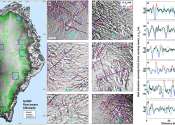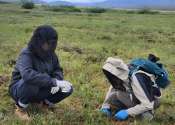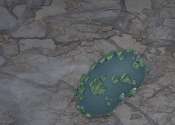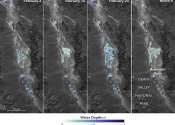Last update:
Earth Sciences news

El Nino not climate change driving southern Africa drought: Study
A drought that pushed millions of people into hunger across southern Africa has been driven mostly by the El Niño weather pattern—not climate change, scientists said on Thursday.
Earth Sciences
2 hours ago
0
1

Weather and climate extremes in 2023 impacting the globe with emerging features
Globally, last year was the warmest for thousands of years, with a globally averaged temperature of at least 1.45°C greater than pre-industrial times. The year also saw an unprecedented string of extreme weather and climate ...
Earth Sciences
13 hours ago
0
20

New geological map reveals secrets of Greenland's icy interior
A team of international scientists involving the Durham University Geography department has unveiled a new map of the geological provinces hidden beneath the Greenland Ice Sheet.
Earth Sciences
14 hours ago
0
1

Anthropocene activities dramatically alter deep underground fluid flux, researchers find
Much of Earth's water is hidden hundreds of meters beneath our feet, among soil particles and deep within rock pores and fractures.
Earth Sciences
15 hours ago
1
24

The Aral Sea has made Central Asia significantly dustier, according to study
The drying up of the Aral Sea has made Central Asia 7% dustier in the last 30 years. Between 1984 and 2015, dust emissions from the growing desert almost doubled from 14 to 27 million tons. This is the result of a study by ...
Earth Sciences
16 hours ago
0
10

Ice age climate analysis reduces worst-case warming expected from rising CO₂
As carbon dioxide accumulates in the atmosphere, the Earth will get hotter. But exactly how much warming will result from a certain increase in CO2 is under study. The relationship between CO2 and warming, known as climate ...
Earth Sciences
16 hours ago
8
71

Field-margin wetlands alone can't fix the Gulf of Mexico's dead zone, say researchers
Each summer, a hypoxic dead zone forms in the Gulf of Mexico, making some marine habitats unlivable. The dead zone is caused by nutrients—primarily from agricultural fertilizers—flowing into the Gulf from the Mississippi ...
Earth Sciences
17 hours ago
0
1

Understanding climate warming impacts on carbon release from the tundra
The warming climate shifts the dynamics of tundra environments and makes them release trapped carbon, according to a new study published in Nature. These changes could transform tundras from carbon sinks into carbon sources, ...
Earth Sciences
18 hours ago
0
9

Scientists navigate the paradox of extreme cold events in a warming world
According to Copernicus Climate Change Service, February 2024 was the warmest February ever recorded globally.
Earth Sciences
18 hours ago
0
293

Sink to source: Does what we put into our plumbing end up back in the water supply?
When you see an advertisement for a detergent promising to brighten your clothes, something called a fluorescent whitening compound, or optical brightener, is probably involved. Such material absorbs UV light and emits visible ...
Earth Sciences
19 hours ago
0
5

CO₂ worsens wildfires by helping plants grow, model experiments show
By fueling the growth of plants that become kindling, carbon dioxide is driving an increase in the severity and frequency of wildfires, according to a UC Riverside study.
Earth Sciences
Apr 16, 2024
1
56

Fires pose growing worldwide threat to wildland-urban interface
Fires that blaze through the wildland-urban interface (WUI) are becoming more common around the globe, a trend that is likely to continue for at least the next two decades, new research finds.
Earth Sciences
Apr 16, 2024
0
54

Researchers reveal oceanic black carbon sink effect driven by seawater microdroplets
Pyrogenic carbon is widely produced during the incomplete combustion of biomass and fossil fuels on land. About one-third of pyrogenic carbon is exported to the ocean by rivers, and thereinto, the refractory fraction becomes ...
Earth Sciences
Apr 16, 2024
0
27

Yellowstone Lake ice cover unchanged despite warming climate
The length of time that Yellowstone Lake is covered by ice each year has not changed in the past century, despite warming temperatures in the region, according to new research led by University of Wyoming scientists.
Earth Sciences
Apr 16, 2024
0
325

Researchers shine light on rapid changes in Arctic and boreal ecosystems
Arctic and boreal latitudes are warming faster than any other region on Earth. In three new studies, Earth system scientists at the University of California, Irvine report how the ecosystems in these regions are changing.
Earth Sciences
Apr 16, 2024
0
335

Uranium-immobilizing bacteria in clay rock: Exploring how microorganisms can influence the behavior of radioactive waste
When designing repositories for high-level radioactive waste in deep geological layers, various factors must be carefully considered to ensure their long-term safety. Among other things, natural communities of microorganisms ...
Earth Sciences
Apr 16, 2024
0
73

Research suggests that part of India will become a climate hotspot
The Indian subcontinent is likely to experience an increasing number of extreme weather events in future. The fertile and densely populated plain around the Indus and Ganges rivers is therefore likely to become a climate ...
Earth Sciences
Apr 16, 2024
0
8

More climate-warming methane leaks into the atmosphere than ever gets reported
Far more methane, a potent greenhouse gas, is being released from landfills and oil and gas operations around the world than governments realized, recent airborne and satellite surveys show. That's a problem for the climate ...
Earth Sciences
Apr 16, 2024
0
18

SWOT satellite helps gauge the depth of Death Valley's temporary lake
California's Death Valley, the driest place in North America, has hosted an ephemeral lake since late 2023. A NASA-led analysis recently calculated water depths in the temporary lake over several weeks in February and March ...
Earth Sciences
Apr 16, 2024
0
26

Hidden threat: Global underground infrastructure vulnerable to sea-level rise
As sea levels rise, coastal groundwater is lifted closer to the ground surface while also becoming saltier and more corrosive. A recent study by Earth scientists at the University of Hawai'i (UH) at Mānoa has compiled research ...
Earth Sciences
Apr 15, 2024
0
2
More news

New radar analysis method can improve winter river safety

Study reveals giant store of global soil carbon

Altered oceanic crust may contribute to arc magmas

NASA's PACE data on ocean, atmosphere, climate now available
Other news

Beyond equilibrium: Scientists investigate Floquet Fermi liquids

Paleontologists unearth what may be the largest known marine reptile

Honey bees experience multiple health stressors out in the field

East coast mussel shells are becoming more porous in warming waters

How a calcium-sensing protein multitasks

'Tube map' around planets and moons made possible by knot theory

New class of antimicrobials discovered in soil bacteria

Verifying the mathematics behind ocean modeling

Humans shape the journey of mud, study reveals

Spintronics: A new path to room temperature swirling spin textures













































